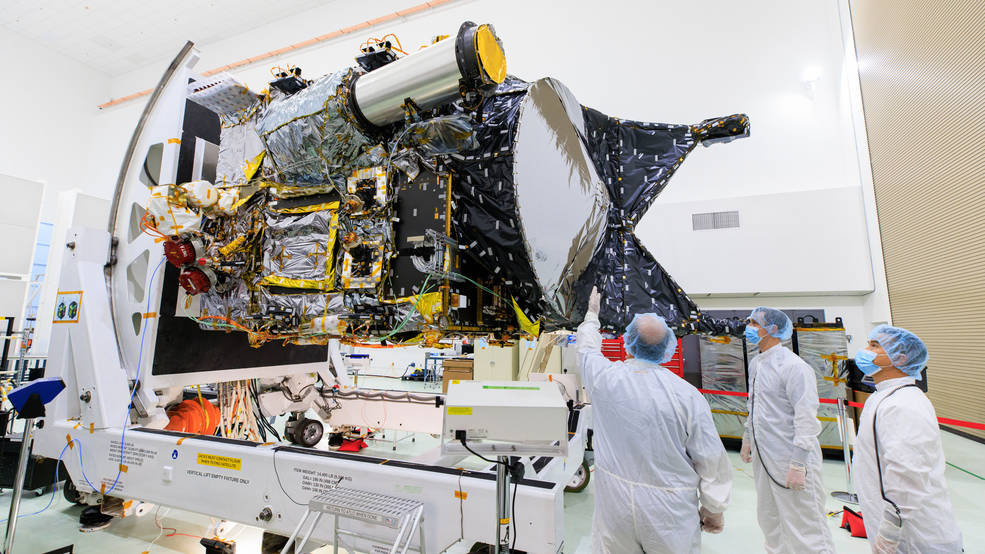When the asteroid Psyche has its first close-up with a NASA spacecraft, scientists hypothesize they will find a metal-rich asteroid. It could be part or all of the iron-rich interior of a planetesimal, an early planetary building block, that was stripped of its outer rocky shell as it repeatedly collided with other large bodies during the early formation of the solar system.
New research from scientists at NASA’s Ames Research Center in California’s Silicon Valley suggests that is exactly what the agency’s Psyche mission will find.
Led by Anicia Arredondo, the paper’s first author and a postdoctoral researcher at the Southwest Research Institute in San Antonio, Texas, and Maggie McAdam, Ames research scientist and principal investigator, the team observed Psyche in Feb. 2022 using NASA’s Stratospheric Observatory for Infrared Astronomy (SOFIA). The now-retired observatory was a Boeing 747SP aircraft modified to carry a reflecting telescope. As a flying telescope, SOFIA collected data that was not affected by Earth’s lower atmosphere and made observations from all over the world, including over the oceans.
For the first time, SOFIA was able to gather data from every part of Psyche’s surface. It also allowed the team to collect data about the materials that make up Psyche’s surface – information that could not be gathered from ground-based telescopes.
Psyche’s potential to answer many questions about planet formation is a key reason why it was selected for close observation by a spacecraft. Scientists believe that planets like Earth, Mars, and Mercury have metallic cores, but they are buried too far below the planets’ mantles and crusts to see or measure directly. If Psyche is confirmed to be a planetary core, it can help scientists understand what is inside the Earth and other large planetary bodies.
Psyche’s size is also important for advancing scientific understanding of Earth-like planets. It is the largest M-type (metallic) asteroid in our solar system and is long enough to cover the distance from New York City to Baltimore, Maryland. This means Psyche is more likely to show differentiation, which is when the materials inside a planet separate from one another, with the heaviest materials sinking to the middle and forming cores.
“Every time a new study of Psyche is published, it raises more questions,” said Arredondo, who was a postdoctoral researcher at Ames on the SOFIA mission when the Psyche observations were collected. “Our findings suggest the asteroid is very complex and likely holds many other surprises. The possibility of the unexpected is one of the most exciting parts of a mission to study an unexplored body, and we look forward to gaining a more detailed understanding of Psyche’s origins.”

More about the Psyche and SOFIA missions:
Arizona State University leads the Psyche mission. A division of Caltech in Pasadena, JPL is responsible for the mission’s overall management, system engineering, integration and test, and mission operations. Maxar Technologies in Palo Alto, California, provided the high-power solar electric propulsion spacecraft chassis.
Psyche is the 14th mission selected as part of NASA’s Discovery Program, managed by the agency’s Marshall Space Flight Center in Huntsville, Alabama. NASA’s Launch Services Program, based at Kennedy, is managing the launch service.
SOFIA was a joint project of NASA and the German Space Agency at DLR. DLR provided the telescope, scheduled aircraft maintenance, and other support for the mission. NASA’s Ames Research Center in California’s Silicon Valley managed the SOFIA program, science, and mission operations in cooperation with the Universities Space Research Association, headquartered in Columbia, Maryland, and the German SOFIA Institute at the University of Stuttgart. The aircraft was maintained and operated by NASA’s Armstrong Flight Research Center Building 703, in Palmdale, California. SOFIA achieved full operational capability in 2014 and concluded its final science flight on Sept. 29, 2022.
For news media:
Members of the news media interested in covering this topic should reach out to the Ames newsroom.
Click here for original story, Clues to Psyche Asteroid’s Metallic Nature Found in SOFIA Data
Source: NASA Ames Research Center